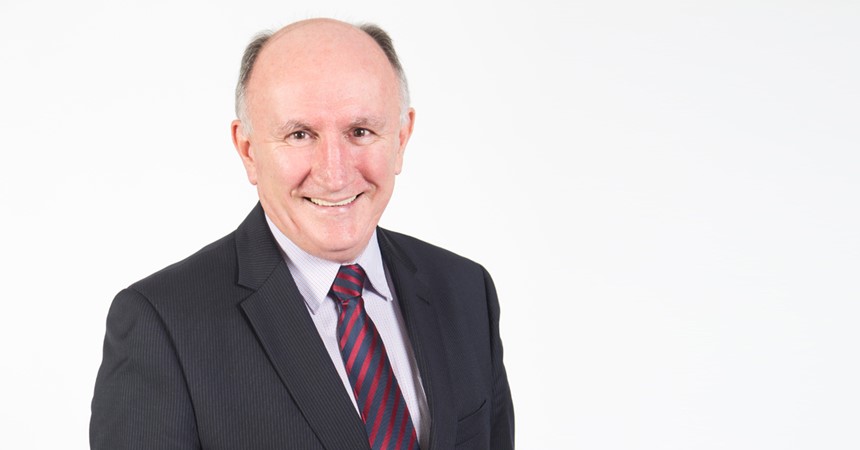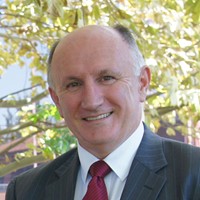On Thursday and Friday representatives from our diocese attended the International Education Symposium hosted by the NSW Minister for Education, Mr Adrian Picoli. Three Principals, Ms Mandy Sanderson, Mr Larry Keating and Mr Anthony Weir attended the symposium and Mr Andrew Cornwall, an Education Officer (Learning Technologies) in the CSO, also attended in his capacity as a Highly Accomplished Teacher. All four were in attendance at the invitation of the Minister.
Andrew had the added privilege of being invited to be part of a panel and was asked to give a ten minute presentation as part of that panel. He drew the last 10 minute slot of the symposium but from the feedback I received did exceptionally well in stimulating and challenging the attendees on the future of education in Australia.
On Friday a large number of principals, parishioners, students from surrounding schools and parents joined Bishop Bill, Frs Kevin Kiem and Kevin Corrigan, Sr Mary Gearson of the Sisters of Mercy, Member for Port Stephens, Kate Washington, Diocesan Vice Chancellor Administration, Sean Scanlon and CSO staff as the name of the proposed new Secondary School for Medowie was announced.
In naming the school as Catherine McAuley Catholic College Bishop Bill also unveiled the foundation stone of the college which will commence in 2020. Catherine was the foundress of the Sisters of Mercy who have served and continue to serve in the Diocese of Maitland-Newcastle for almost 150 years. As a young woman Catherine reached out to the poor, the destitute and the youth of Dublin and whilst starting with a small group of supporters soon established the Sisters of Mercy who have specialised in education, health, missionary work and the continued care of the poor, marginalised and refugees throughout the world.
The naming of the college after Catherine acknowledges the location of Medowie as being close to the centre of an area where the Sisters of Mercy founded and staffed Catholic schools in Stockton, Tarro, East Maitland, Rutherford, Morpeth, Tenambit, Millers Forest, Raymond Terrace and Nelson Bay. The schools at Tenambit, Morpeth and Millers Forest have been closed for a number of years but the others continue to provide a quality Catholic Education in keeping with the Mercy tradition.
On Saturday, along with approximately 70 parishioners from across the diocese, teachers and students, I participated in the Murray Pilgrimage, a walk from Morpeth to the soon to be re-opened St John’s Chapel, the original cathedral of the diocese in Maitland. Bishop Bill, Fr Paul O’Neill, Parish Priest of the parishes of the Chisholm region and Fr Geoff Mulhearn, former Parish Priest of the Chisholm Region were part of the walk which featured a number of stops and talks focusing on the history of the diocese and the arrival of Bishop James Murray 150 years ago.
The first talk was from Bishop Murray himself, or a neatly disguised Mark Spencer, at Queen’s Wharf, Morpeth, who regaled us with the history of his time as the first resident Bishop of the diocese. Next was a talk by Peter Bogan, at East Maitland Railway Station, on the Irish of Maitland, outlining the impact on the Maitland region of Irish convicts, free settlers and refugees from the Irish Famine. We were then entertained at St Joseph’s Primary School, East Maitland by an appearance of Caroline Chisholm (Sr Maureen Salmon rsj) and Sr Hyacinth Donnellan OP (Sr Denise Sullivan OP). Caroline outlined the amazing work she undertook with the poor and destitute women of the colony and her work to foster the immigration of families to Australia. Sr Hyacinth reported on the arrival of the Dominican Sisters at the invitation of Bishop Murray to establish a “magnificent school in Maitland in order to give a prestige to Catholic Education in this district”.
At Ministers Park and Horseshoe Bend, Maitland local historian, Michael Belcher, outlined the history of the Hunter River and the early landforms and flare of the Maitland region. He also spoke of the development Horseshoe Bend residential area, initially a haven for destitute, male, former Irish Convicts and later a strong multi-denominational community that always supported one another.
The final point was on the banks of the Hunter, overlooking the former cathedral as Bishop Bill and Barry Urwin on the history of St John the Baptist Church later to become Bishop Murray’s Cathedral and now being restored to its former glory.
It was an amazing experience, following the route Bishop Murray took on his arrival in Morpeth in 1866 and his claiming St John the Baptist as his Cathedral on 1st November that year. I extend to the organisers of the Pilgrimage my congratulations on what was a superbly organised pilgrimage that did great credit to the rich history of the diocese.
I was particularly grateful to be the recipient, along with all the pilgrims, of the hospitality of Anthony Weir and the Parents and Friends of St Joseph’s Primary School, East Maitland and Bernard Burgess and the P&F of All Saints College, St Peter’s Campus.
It certainly has been an enlightening few days.

